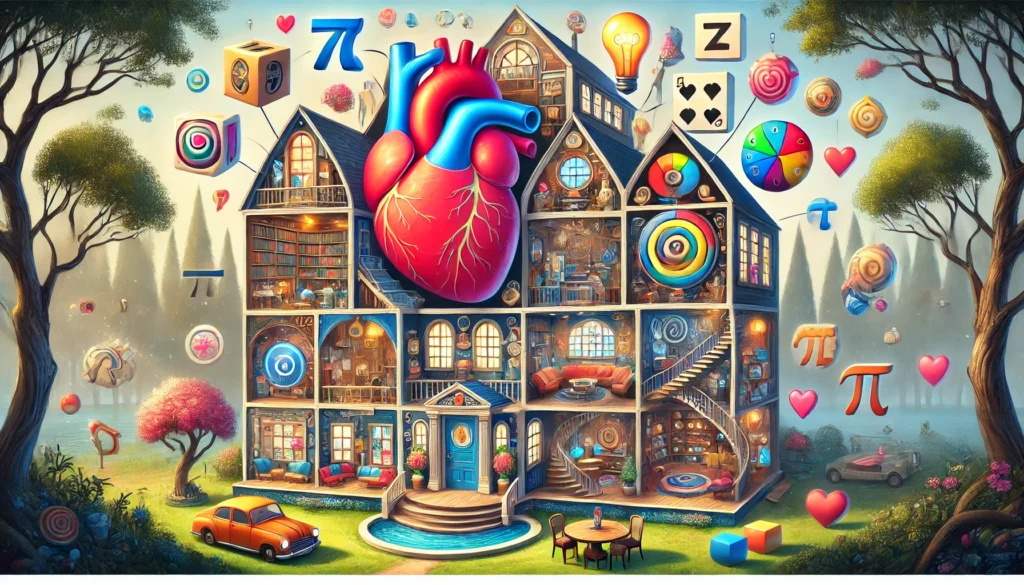Whoever among us has read Sherlock Holmes or watched adaptations has likely had that urge to be like him, whether secretly or openly, right? Take my apology; I can’t tell you the process of becoming Sherlock Holmes, but hey, folks, I can do you a favor. From here you will definitely learn the Sherlock Holmes memory secret. Yes, I’m talking about the concept of the mind palace, which is a great way to memorize everything. Thanks to Sherlock Holmes, this character made this concept so famous.
Although this concept wasn’t created by Sherlock Holmes, it’s a century-old method credited to the ancient Greeks. A mind palace is a technique that uses loci to memorize large amounts of information by combining visual and spatial memory. “Loci” is a Latin word that means “places.”
This mind palace method is so effective for memorizing things that many memory champions use this technique to perform incredibly well in memory challenges, like memorizing pi digits, deck of cards, binary numbers etc. So, how does it work?
A Simple Example of How the Memory Palace Really Works
Imagine you have a big presentation at work, and you need to remember several key points to discuss. Instead of stressing over your notes like a chicken with its head cut off, you decide to create a mind palace.
First, visualize your home, which you know inside and out. You start at the front door, where you imagine placing the first key point: “Introduction”. You see yourself opening the door and saying, “Welcome to my presentation!” This sets the stage for your audience.
Next, you walk into the living room, where you visualize the second point: “Market Analysis”. Picture a giant graph hanging on the wall, displaying market trends. You mentally note the important statistics while admiring the graph.
As you move to the kitchen, you think of the third point: “Product Features”. Imagine your favorite cooking utensils on the counter, each representing a different feature of your product. For example, a whisk might symbolize its mixing capabilities.
You then head to the dining room for the fourth point: “Target Audience”. Picture a beautifully set table with place settings for different demographics. Each food item represents a different group you want to reach.
Finally, you enter your bedroom, where you visualize the fifth point: “Call to Action”. Imagine a large, inviting bed that symbolizes rest and comfort, reminding your audience of the peace of mind they’ll gain by choosing your product.
As you mentally walk through your home, each room triggers your memory of these key points, helping you deliver a confident presentation without the need for notes.
Does the concept feel like it’s going over your head? Don’t worry! Let’s break it down step by step so it all makes sense.
The first step in creating your memory palace is to create a memory map. Imagine picking a location in your mind—a place you know every inch of it. It could be your cozy bedroom, the living room where you hang out, or even that park where you go for an evening walk. Selecting the proper location is the key of this method because this will be the foundation for storing the things you wish to remember.
Create A Memory Map:
The trick? It has to be a place you’re already familiar with, so you don’t have to waste mental energy recalling the map itself.
The magic of a memory palace lies in how our brains work. We naturally connect new information to what’s already stored in our long-term memory. Our brains link old memories to new ones effortlessly. The main goal of the memory palace technique is to apply this God gifter process effectively.
When selecting your memory map, choose a location where every detail is deeply imprinted in your mind. Walk through it in your imagination with ease—picture the details, the furniture, the colors, and even the smells. The more vivid and personal the location, the easier it will be to recall everything later. Whether it’s the place you sleep in, the street you go down every day, or your favorite park spot, your memory map becomes a mental gold mine for all the information you want to keep.
Choosing Your Key Items in Memory Map:
Now, let’s go on to step two – choosing your main items.Once you can mentally go through your memory palace without struggling to recall details, it’s time to assign key items. In each room, choose four or five standout items. The best options could be furniture, artwork, windows, decorations, or any noticeable features. Just remember to avoid selecting multiple similar objects in the same room. For instance, if you’re working with a bedroom, don’t choose each pillow on the bed as a separate item; instead, think of the whole bed as one complete object. This will help prevent confusion when you start attaching new information.
As you make your selections, don’t get caught up in doubts like, “What if this couch moves in the future?” or “This couch has been in different places in the past.” If those thoughts creep in, just skip the couch altogether. Right now, we want to focus solely on items that are rooted in your memory—nothing imaginary or pretend. This approach ensures that you won’t have to strain to visualize the items; they should be as familiar to you as the back of your hand.
For example, in the first place of my personal memory palace would be a place where I regularly play football. In this space, I see a well-worn football in the center of the field, goalposts at either end, a set of benches for players along one side, a water cooler nearby, and vibrant corner flags marking the boundaries.I’ll choose specific items to help anchor my memories. For instance, I might pick the football itself to remember a particular piece of information, the entire set of benches along the sidelines to recall a different concept, the goalposts to represent a goal I want to achieve, the water cooler to remind me of hydration tips, and the vibrant corner flags to signify various strategies.
This is a lively scene filled with distinct items that are easy to remember because I often spend time there. The variety in these objects makes it simple to distinguish them from one another.
Once you’ve got this part down, you’ll be ready to move on to the next step in building your memory palace!
Establishing Your Route:
Now that your memory palace is organized and you’ve selected your key items, it’s crucial to determine a route that you will consistently follow when recalling information. You may think it’s not an important step and that you can navigate your memory map in any way you like. For instance, if you’ve chosen your bedroom as a memory map, you might enter through your door or your window in your imagination. However, that’s not the main gist of the memory palace technique. Remember, the core of how a mind palace actually works is rooted in repetition and visual cues. Therefore, maintaining a fixed route through your memory map is essential.
Many people find it useful to assign numbers to the key objects in their palace. For instance, you could start by entering through the front door, turning right, and then moving through your house in a counterclockwise pattern. You’d continue this path through each room until you eventually circle back to where you began.
Once you’ve established your route and know it very well, you’re ready to start incorporating new information! A simple way to verify your readiness is to quiz yourself. For instance, ask, “What’s the third item in the second room?” If you can answer confidently, you’re prepared to expand your memory palace with additional knowledge!
Adding Information to Your Memory Palace:
Now comes the exciting part step number four— actually placing information into your memory palace. By now, you should have a clear mental layout of your rooms and the key objects within them. The next step is to associate something memorable with each object in your palace. Since the mind palace is a visual memory technique, you need to turn whatever you want to remember — whether it’s numbers, facts, or even a speech — into vivid mental images.
There are a few ways to do this, but creativity is key! The goal is to transform information into something visually and sensory stimulating. Think bright colors, exaggerated shapes, sounds, textures, and movement. The more outlandish, the better. Let’s look at two examples: memorizing a deck of cards and the digits of pi.
Memorizing a Deck of Cards:
Let’s say you want to memorize a shuffled deck of cards, and your first card is the Ace of Hearts. Instead of creating a new object, you’ll associate the Ace of Hearts with something that already exists in your memory palace. For instance, if your first location is a coat rack by the front door, visualize a large, vibrant red heart hanging from the coat hook where you usually keep your jacket. This heart becomes a visual cue that will remind you of the Ace of Hearts every time you visit that spot in your mind.
Now, let’s say the second card is the Four of Spades. If the second object in your mind palace is a mirror in your hallway, imagine seeing four black spades (shovels) in the reflection, or picture scratches on the mirror that form the number “4” along with spade shapes. This reinforces the idea without introducing something entirely foreign to your palace.
Memorizing the Digits of Pi
Now, for the digits of pi — 3.14159. If the first object in your memory palace is a sturdy table in your entryway, you can imagine the number “3” carved into the surface. The second object, a lamp, can be visualized as glowing with one single, bright flame to represent the number 1. For 4, if the next object in your palace is a chair, you might picture its four legs prominently in your mind, each one representing the number 4. The more natural and familiar the object, the easier it becomes to create strong associations.
Pro Tip: It’s crucial to ensure that the memory palace technique is worth your time. Use it to memorize information that truly matters to you. Whether it’s important facts for an exam, key concepts for your work, or memorable quotes, focusing on relevant information will make your efforts more effective and meaningful. The strength of this technique lies in its application to knowledge that impacts your life or studies.
Creating Multiple Memory Palaces:
However, a common concern many people have about the mind palace technique is this: What happens if you add more information and your brain gets tangled up between two different lists? It’s a valid worry, but the solution is surprisingly simple, even if it requires a bit more effort.
Yes, that’s right! You can absolutely create multiple memory palaces. Just think about it—you’re familiar with numerous places around you, so why not use that to your advantage? Many memory champions dedicate different palaces for various topics. For example, one might be reserved just for cards, another for numbers, one for lists, and yet another for speeches.
Now, here’s the catch: each additional palace demands time and effort to build and memorize. If that sounds like a lot of work just to set up your memory system, you’re spot on! It’s not just a single technique; it’s at least five different methods converging into one powerful system. The secret is in harmonizing all these elements to create a nearly seamless experience. And let’s step away from the Sherlock Holmes mythos—there’s no need to say, “I must go to my mind palace.” The real goal is to absorb and internalize the information itself. By utilizing these five systems, you can ensure that the information embeds itself in your long-term memory, allowing you to access it effortlessly whenever you need it. Once you’ve trained your mind with these individual sets of information, the mnemonics and the memory palace itself will fade into the background, leaving you with just the essential knowledge when you need it. And that’s a truly glorious and beautiful thing!



